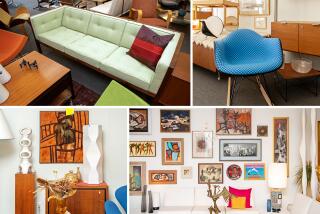Restoration Hardware Retools to Boost Sales
Restoration Hardware Inc., the upscale home-goods retailer that made its name selling to nostalgic baby boomers, next week will unveil its own attempt at restoration.
After three straight years of losses stemming from overexpansion, the Corte Madera, Calif.-based chain will inaugurate remodeled stores, a fancy new product mix, revamped catalogs and an overhauled Web site.
For the record:
12:00 a.m. April 11, 2002 FOR THE RECORD
Los Angeles Times Thursday April 11, 2002 Home Edition Main News Part A Page 2 A2 Desk 2 inches; 36 words Type of Material: Correction
Restoration Hardware--A story about Restoration Hardware in Fridayâs Business section misstated the number of stores the company will close over the next two years. Company executives anticipate closing six to eight, not 68, under-performing stores.
The goal is to entice well-heeled customers over 45--who already might be fans of Restorationâs simple and classic furniture--with goods such as extra-thick Turkish towels and luxury Italian bedding.
Restoration executives say their new model will succeed in part because it fills a void in the middle-to-top tier of home goods, between the exclusive world of custom interior designers on one end and higher-price housewares and furniture chains on the other.
But that can be a difficult niche, especially because many shoppers in recent years have moved away from middle-tier offerings, choosing either very high-end or bargain goods.
But Friedman maintains that the new Restoration Hardware will draw some customers from interior design clients in search of more moderate prices on replacement or less important items.
The majority of the new shoppers, he says, will come as aging customers of stores such as Pottery Barn grow out of the trendier, more moderately priced furnishings and look for a more lasting, higher-quality alternative.
Adding to Restoration Hardwareâs challenges are the inherent difficulties of the large-scale furniture business and the persistent problems many retailers face as they tackle a store-based and direct-to-consumer business.
All of which adds up to a high-stakes program for the firm and its new leader, Chief Executive Gary Friedman.
Having teetered on the brink of bankruptcy 18 months ago, Restoration must prove its new concept to investors and consumers in short order.
And for Friedman, who left the presidency of Williams-Sonoma Inc. a year ago after being passed over for the top job, the new and improved Restoration Hardware offers a chance to demonstrate that he is more than just the brilliant merchant behind the cooking supplies retailer and its Pottery Barn unit.
âPeople are willing to pay more for higher-quality items, so I think the conceptual potential is fantastic,â said Anne-Marie Peterson, an analyst with Thomas Weisel Partners.
âBut operationally, what they are doing is pretty complex. Retailers who have been in those businesses successfully for years still struggle with many of those issues.â
Still, as with any retail overhaul, central to the new stores is the new merchandise.
One of Friedmanâs first moves at Restoration was to overhaul the merchandise, clearing out 7,000 of 9,000 items in the average store in favor of new products and reducing the number of products by 30%.
âWe were way over-assorted in Slinkies and pickup sticks and auto bingo and things like that,â Friedman said.
âWeâve edited that back quite a bit, probably by a half to two-thirds, but what youâll find is that those items will still be sprinkled throughout the store.â
The new buying team, composed largely of former Williams-Sonoma merchandisers, promises greater depth in many product areas that had been doing well and new items designed to boost profit margins and sales.
It plans to lower prices on many beds, for example, in order to increase sales of night stands, dressers and other matching products. Whereas previous collections have had one bed per furniture style, the new formula calls for three in the same amount of floor space--with pictures of the expanded offerings displayed alongside floor models from the same collection.
But the biggest change will come in textiles, a high-margin product group that Friedman says will go from 4% of the product mix to 20% by year-end.
New will be $300 sets of 464-thread-count Italian sheets, Belgian linen window treatments selling for $90 to $160 and hand-knotted Persian rugs.
Friedman projects sales increases of 15% per year to $4 million to $5 million per store, and sales from catalogs and the Web to grow from $23 million in 2000 to $300 million over the next five years. Earnings, Friedman said, will rise 30% to 50%--enough to make the company profitable for the first time since 1998, when it went public.
To get there, Friedman had to slow the companyâs growth, closing three stores last year and planning to shut 68 more under-performing sites over the next two years. No new stores are planned until 2003, when the company is scheduled to open 12.
âFurniture is an extremely tough business, but sometimes when things are really challenging, the right person can come in and find tremendous opportunity,â said Ted Janus, a partner with Palo Alto Investors, which began buying shares of Restoration Hardware in November.
âWe think we have a first-class merchandiser in there going after an exciting demographic.â
*
(BEGIN TEXT OF INFOBOX)
Restoring Restoration
(text of infobox not included)
More to Read
Inside the business of entertainment
The Wide Shot brings you news, analysis and insights on everything from streaming wars to production â and what it all means for the future.
You may occasionally receive promotional content from the Los Angeles Times.








